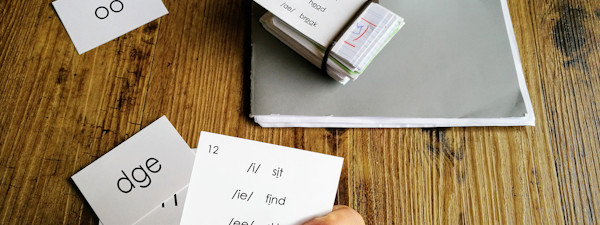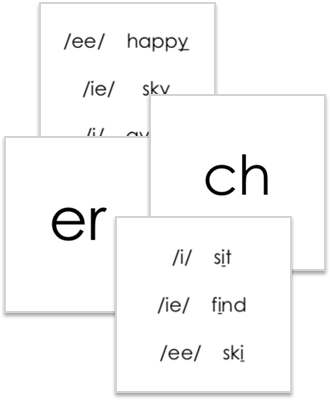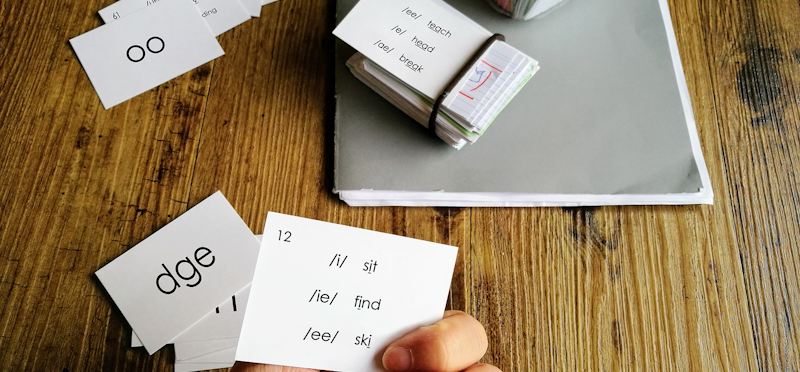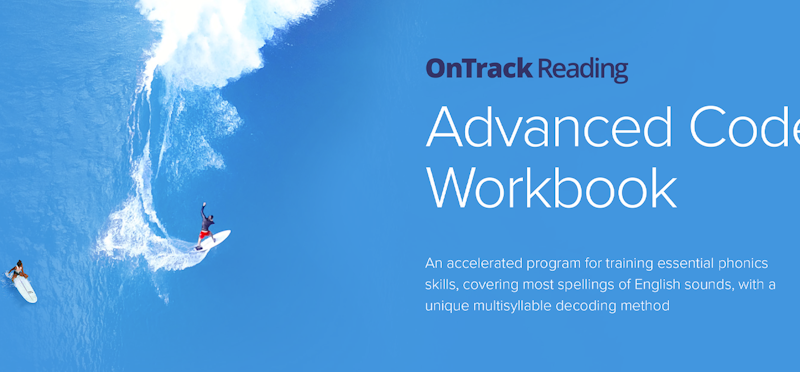
The OnTrack Reading Phonogram Flash Cards were originally designed as a replacement for the flash cards in the original Spalding Method. But because they faithfully represent the coding system used across all of the OnTrack Reading phonics programs, they can serve other useful purposes. Those alternative purposes are the subject of this article.
Note that if you download the PDF, you will need to print the pages out on your home printer, using card stock, and then cut them into individual cards.
Download the OnTrack Reading Phonogram Flashcards

Review of the Intended Use of the Flash Cards
They were originally created to be used with the OnTrack Reading Homeschooling Program, an adapted version of the exceptional reading and spelling program designed by Ms. Romalda Spalding decades ago and completely presented in her book, The Writing Road to Reading. A large number of homeschoolers, as well as many public schools, have found her program to be invaluable for the initial teaching of reading and spelling. Materials for the Spalding Method, as it is commonly known, are available from various sources if one wants to use the program in its original form.
My redesign of the program, and the reasoning behind that redesign, are discussed extensively at the above link. One of the changes was a restructuring of the phonograms proposed by Ms. Spalding. The OnTrack Reading Phonogram Flash Cards replace the flash cards in Ms. Spalding's original program. You will need them if you intend to use the modified program discussed here on the site.
Other Potential Use of the Flash Cards
First, you can use them to review the advanced code following completion of the OnTrack Reading Phonics Program. The phonics code presented on the flash cards is exactly the same as in the Advanced Code Phonics Workbook used in that program. They are not needed during the program, but could easily be used to review the phonics code taught during the program.
The flash cards summarize the code knowledge taught during the course. For example, a student learns that the letter e can represent either the /e/ sound or the /ee/ sound during the course. The flash card for that letter indicates that those are the two sounds, that they are the only two sounds, and gives the preferred order to test them in an unfamiliar word. Thus, the card provides an excellent summary of what was taught.
This review could be done periodically after the workbook was completed, or it could take place during the workbook program. For example, the digraph sh is covered in one of the first lessons. Pull the card for it and note that it has only one permissible sound. So put it aside for reviewing later. Add other cards as their associated spellings are covered in the workbook. Some spellings occur two or more times. For example, the flash card for the digraph ow indicates that it can represent both the /ow/ and the /oe/ sounds. So once the /ow/ and /oe/ lessons are completed, that card could be pulled from the set of cards and used for review.
The stack of cards to be reviewed would grow as you progress through the workbook, but would also shrink as you removed cards that you were confident the child had learned well.
Another Potential Use of the Flash Cards
Use them as a stand-alone phonics presentation.
Frankly, I doubt using the flash cards alone would work with struggling readers. If a child is already struggling to read, I would recommend the OnTrack Reading Advanced Code Workbook, because that is exactly the use for which it was designed. However, if you have a child who is learning to read easily, the flash cards could be quite useful in getting that child to systematically organize the phonics advanced code in his or her mind.
Were I to use the cards in this way, I would point out various examples during reading such as, for example, the /o/ sound of the letter "a" in a word like "want," and would eventually show the child the letter "a" flash card and explain that the first sound is /a/ (bat), the second is /ae/ (table) and the third is /o/ (want), and would then challenge the child to learn those options in that particular order, and to be able to recite them when shown the letter "a" flash card.
Of one thing I'm certain. A child that learned all of the flash cards well would have no trouble with the English phonics advanced code, for the flash cards cover almost all of the useful phonics code. They don't, however, cover the rare instances. Those usually have to be memorized as peculiarities of English, such as the /a/ sound of the digraph ai in plaid, for example or the /i/ sound of the letter u in busy.
And Finally, One Last Use, as a Potential Standard
A lot of thought went into the content on the flash cards. There were two goals. First, the cards had to cover most of the useful phonics code. And, second, the code was to be presented as simply as possible so even young children could handle learning it. I believe both of those goals were achieved although, if I were to add to the set today, I would include four more digraphs, the bu in buy and build, the ending te in paste and infinite, the marker dg in badger and hedges, and the ending the in soothe and lathe. Each of these occur in enough words to make teaching them worthwhile.
So the last use is to serve as a standard. With the addition of the last four digraphs mentioned above, the full set comes to 88 items of code. I believe that each of them is worth teaching and that the sounds associated with them is exactly what should be taught to a young child learning to read. Others will no doubt disagree, but they should make their cases for inclusions or exclusions and we should eventually come to an agreement on a true standard of the phonics code. That standard should then be incorporated into any phonics curriculum being taught. That way, a child could move across the country and still be assured of learning the same phonics structure as he was being taught at his old school. This only makes sense, and it should be public policy to devise such a standard and insist upon it being taught.
Another advantage of designating a standard phonics code is that, once established, anyone could learn it if they wanted to do so. And then they could share that knowledge with those still learning. No longer would parents and grandparents have to sit by quietly, concerned that telling a child that the letter a in the word father was its third sound, /o/, might conflict with what the school was teaching the child.
Creating such a standard, be it this one, or another, is an essential step to ensuring that phonics instruction gains a place in the reading curriculum of all schools, and remains there.



